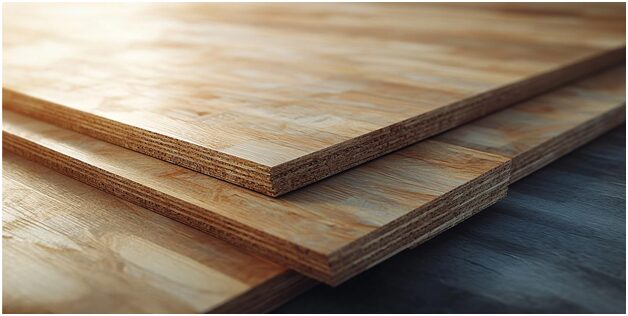When working on interior design projects at home, choosing the right plywood is crucial. Plywood is versatile, affordable, and comes in various types suited to different applications, such as furniture, wall paneling, and cabinetry.
Understanding the different plywood types can help you make the best choice for your specific needs, whether you’re designing wardrobes, cabinets, or wall features. Below, we explore seven popular plywood types commonly used in home interiors.
1. Commercial Plywood

Overview:
Commercial plywood is one of the most commonly used plywood types for general interior applications. It’s made by bonding thin layers of wood veneer, with alternating grain directions for enhanced strength. This type of plywood is ideal for light-duty applications.
Applications:
Commercial plywood is great for projects like plywood for wardrobes, basic furniture, and plywood for wall paneling. It’s a good choice for areas that don’t need heavy-duty moisture resistance.
Pros:
- Affordable and widely available
- Easy to cut and work with
- Ideal for plywood for interior walls and furniture
Cons:
- Not as durable as other types
- Less moisture-resistant, so not ideal for kitchens or bathrooms
2. BWR (Boiling Water Resistant) Plywood

Overview:
BWR plywood is specifically designed to withstand exposure to moisture. The adhesive used is water-resistant, making it perfect for areas where the material might be exposed to water or high humidity. It’s a step up from regular plywood in terms of durability and moisture resistance.
Applications:
BWR plywood is perfect for plywood for kitchen cabinets, bathrooms, or any area where moisture levels are high. It’s also a good choice for plywood for wardrobes that might experience humidity changes.
Pros:
- Water-resistant and durable
- Suitable for plywood for kitchen cabinets and other moisture-prone areas
- Long-lasting performance in humid environments
Cons:
- More expensive than commercial plywood
- Requires more care in handling due to its sturdiness
3. MR (Moisture Resistant) Plywood

Overview:
MR plywood is treated to resist moisture but is not as resistant as BWR plywood. It uses a special adhesive to prevent swelling and warping when exposed to humidity, making it ideal for indoor environments.
Applications:
MR plywood is often used for plywood for furniture, wardrobes, and general-purpose interior work. It’s a cost-effective option for areas like living rooms and bedrooms where moisture exposure is limited.
Pros:
- Affordable and moisture-resistant
- Ideal for general interior furniture and plywood for wardrobes
- Can handle moderate humidity in homes
Cons:
- Not suitable for high-moisture areas like kitchens or bathrooms
- Not as durable as BWR or Marine plywood
4. Marine Plywood

Overview:
Marine plywood is one of the best plywood types when it comes to moisture resistance. It is made using high-quality wood veneers and durable adhesives that can withstand harsh conditions, including constant exposure to water.
Applications:
Although primarily used in boat building, marine plywood can be a good choice for areas with high water exposure, such as plywood for kitchen cabinets or outdoor furniture. It’s also great for any plywood for wall paneling in damp areas like basements.
Pros:
- Extremely resistant to moisture and water
- Durable and strong, great for heavy-duty applications
- Long-lasting even in wet conditions
Cons:
- Expensive
- Overkill for most typical indoor applications
5. Veneer Core Plywood

Overview:
Veneer core plywood is a high-quality plywood with a thin veneer covering a solid core. This type is known for its smooth surface and aesthetic appeal, making it ideal for decorative applications. It’s often used in high-end furniture and cabinetry.
Applications:
Veneer core plywood is often used for best plywood for furniture and projects where appearance is just as important as strength. It’s perfect for creating polished furniture, cabinetry, and plywood for interior walls that require a smooth finish.
Pros:
- Smooth surface, ideal for finishing
- High-quality appearance for furniture and cabinetry
- Strong and durable
Cons:
- More expensive than commercial plywood
- May not be as moisture-resistant as other types
6. Flexi Plywood

Overview:
Flexi plywood is specifically designed to be flexible and can bend without breaking. It’s a thinner, more lightweight option that’s great for creating curved shapes or designs that require a high level of flexibility.
Applications:
Flexi plywood is commonly used for curved furniture, custom wall features, and unique architectural designs. It’s perfect for creating plywood for wall paneling with curves or unique forms, or for projects requiring lightweight yet durable plywood.
Pros:
- Highly flexible and easy to bend
- Great for custom, curved designs
- Lightweight but still strong enough for most projects
Cons:
- Not as strong as thicker plywood options
- Can be difficult to handle for larger projects
7. Laminated Veneer Lumber (LVL)

Overview:
Laminated Veneer Lumber (LVL) is an engineered wood product made by bonding thin layers of veneer together with adhesives. It’s often used in structural applications due to its high strength, but it can also be used for interior design purposes.
Applications:
LVL is commonly used for plywood for furniture that needs to bear heavy loads, as well as for structural elements like beams. It can also be used for plywood for wall paneling in areas where additional strength is needed, or for large, custom pieces of furniture.
Pros:
- Extremely strong and durable
- Ideal for heavy-duty applications and structural elements
- Resistant to warping and splitting
Cons:
- Heavier and thicker than regular plywood
- More expensive than other types of plywood
Bottom Line
Choosing the right plywood for furniture, cabinetry, or wall applications can significantly impact the final result of your project. Whether you need moisture resistance for plywood for kitchen cabinets or a smooth, aesthetic surface for plywood for interior walls, the type of plywood you select should match your specific needs.
Commercial plywood is a budget-friendly choice for basic projects, while BWR plywood is ideal for areas with high moisture exposure. For more durable and visually appealing projects, marine plywood and veneer core plywood are excellent options. And if you’re looking to add a creative touch, flexi plywood is great for curved designs and unique shapes.
Disclaimer
The information contained in this website is for general information purposes only. The information is provided by BhaskarLive.in and while we endeavour to keep the information up to date and correct, we make no representations or warranties of any kind, express or implied, about the completeness, accuracy, reliability, suitability or availability with respect to the website or the information, products, services, or related graphics contained on the website for any purpose. Any reliance you place on such information is therefore strictly at your own risk.
In no event will we be liable for any loss or damage including without limitation, indirect or consequential loss or damage, or any loss or damage whatsoever arising from loss of data or profits arising out of, or in connection with, the use of this website.
Through this website you are able to link to other websites which are not under the control of BhaskarLive.in We have no control over the nature, content and availability of those sites. The inclusion of any links does not necessarily imply a recommendation or endorse the views expressed within them.
Every effort is made to keep the website up and running smoothly. However, BhaskarLive.in takes no responsibility for, and will not be liable for, the website being temporarily unavailable due to technical issues beyond our control.
For any legal details or query please visit original source link given with news or click on Go to Source.
Our translation service aims to offer the most accurate translation possible and we rarely experience any issues with news post. However, as the translation is carried out by third part tool there is a possibility for error to cause the occasional inaccuracy. We therefore require you to accept this disclaimer before confirming any translation news with us.
If you are not willing to accept this disclaimer then we recommend reading news post in its original language.





